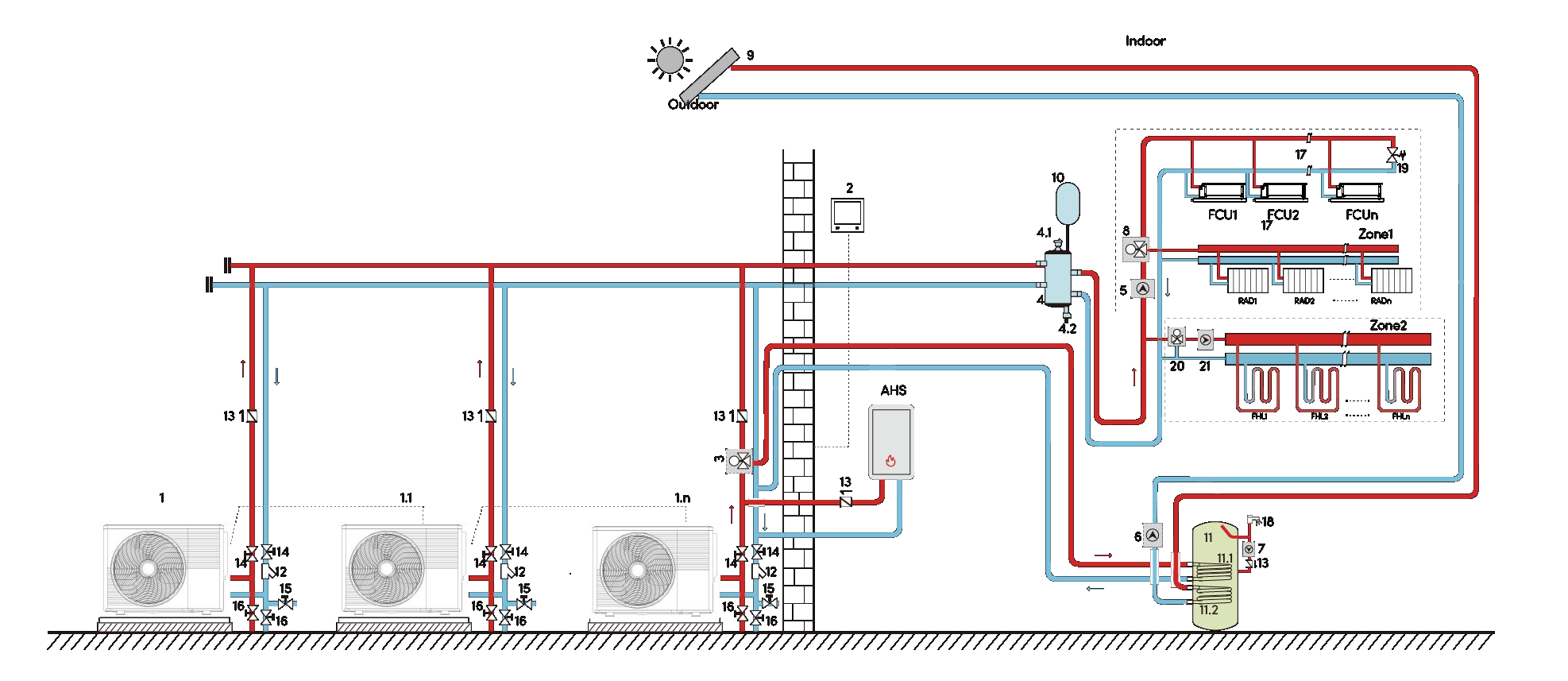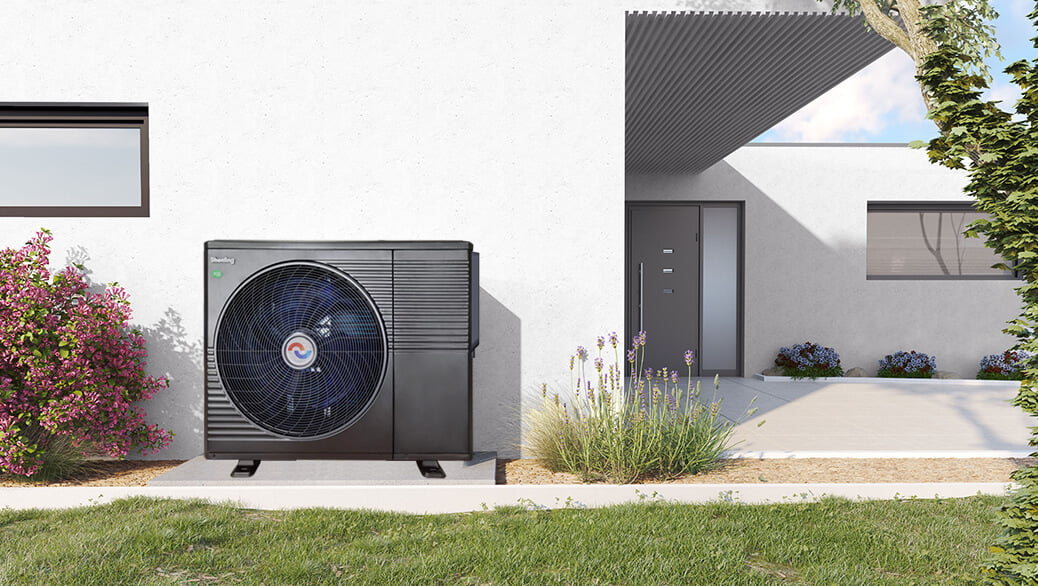
What is Air Source Heat Pump Cascade Systems?
As the demand for efficient and eco-friendly heating solutions grows, air source heat pumps have emerged as a reliable alternative for residential and commercial spaces.
Do Heat Pumps Work In Cold Winter (Real Case And Expert Advise)
The answer is yes, heat pumps are designed to provide both heating and cooling functions. Heat pump is a stable heating alternative for boilers in most families.

Heat pumps have emerged as an essential tool in the battle against climate change, not only in warmer regions but nationwide. These systems offer significantly greater energy efficiency compared to traditional heating and cooling methods, resulting in substantial reductions in household carbon emissions. This advantage becomes even more pronounced when heat pumps are powered by clean sources of electricity.
Notably, President Joe Biden recently authorized the use of the Defense Production Act to expedite the production of critical clean energy technologies, including heat pumps. This signifies the growing recognition of heat pumps as a crucial solution to address environmental concerns. By promoting the manufacturing of these efficient devices, the government aims to accelerate the transition towards cleaner and more sustainable heating and cooling options.
Although air-source heat pumps are the most commonly used type due to their ease of installation and cost-effectiveness compared to ground-source heat pumps, there has been a prevailing belief that they are not suitable for areas that experience freezing temperatures. This perception arises from the fact that air-source heat pumps extract heat from the outdoor air and transfer it indoors, making their operation more challenging in cold weather.
The general understanding was that these systems struggle to maintain comfortable indoor temperatures even during mild cold spells, and their efficiency is compromised under such conditions. Consequently, it was widely assumed that expensive and complex ground-source heat pumps, which extract heat from underground, were necessary for achieving highly efficient electric heating in cold climates. However, advancements in technology and the recognition of the benefits of air-source heat pumps have challenged this notion, revealing that they can still be viable and efficient options even in colder regions, further expanding their potential for combating climate change.
Click here to view the actual case of how do air source heat pumps work in cold weather and what is the best way to run a heat pump in winter.
However, the perception that air-source heat pumps are ineffective in cold climates is outdated. Modern air-source heat pumps, referred to simply as “heat pumps” in this article, when installed correctly, can effectively keep homes warm even in bone-chilling cold weather while consuming significantly less energy than other heating systems. Moreover, many homeowners can save money by using a heat pump.
While Consumer Reports has not specifically tested whole-house heating and cooling equipment, including heat pumps, studies and real-world experiences provide ample evidence that heat pumps can indeed deliver reliable performance.
According to Dave Lis, director of technology and market solutions at Northeast Energy Efficiency Partnerships (NEEP), air-source heat pumps can serve as the primary heating system in nearly any climate. This statement is supported by the testimony of Derek Traxler, a computer repair technician from Minneapolis. Traxler installed a heat pump after his steam boiler malfunctioned and found that it effectively kept his home warm during extreme cold snaps, with temperatures plunging as low as minus 29°F. Traxler even shared a thermal imaging camera video on YouTube to demonstrate the heat pump’s excellent performance. He expressed his satisfaction, stating that “the performance has been great.”
It is worth noting that there are individuals who claim to have experienced a cold home and high utility bills after spending a significant amount of money on heat pump installation. However, this is more likely to occur if the contractor handling the installation is unfamiliar with heat pumps.
Choosing the appropriate equipment for your home and climate, implementing any recommended weather-sealing upgrades, and hiring a reputable contractor with expertise in heat pump installation are key factors that can lead to a positive outcome. For further guidance on the installation process and what to expect, refer to our heat pump buying guide.
Shenling will be the best solution of how to use a heat pump in winter
While an official “cold climate” standard for heat pumps is yet to be established, the upcoming Energy Star standard for air-source heat pumps, set to launch in January 2023, will introduce a certification mark specifically for cold-climate heat pumps. This mark will indicate a suitable level of low-temperature performance and efficiency.
In the meantime, the NEEP (Northeast Energy Efficiency Partnerships), led by Dave Lis, maintains a database of heat pump models that excel in cold weather conditions. Many of the models in this database demonstrate effective heating capabilities even at frigid temperatures as low as 5°F, as well as at mild temperatures of 47°F. These heat pumps are specifically designed to withstand the significant temperature fluctuations experienced in the Northeast and Midwest regions throughout winter.
A critical feature to look for in a cold-climate heat pump is a variable speed compressor, powered by an inverter. While this type of compressor can benefit heat pumps in any climate, its advantages are especially notable in regions with distinct seasonal variations. It enables a single heat pump to operate efficiently and effectively during the harshest winter freezes, the most sweltering summer afternoons, and all the moderate days in between.
Another advantage of a variable-speed system is its ability to maintain a more stable indoor temperature (and humidity level) compared to traditional single-speed HVAC systems. Iain Walker, PhD, a mechanical engineer and building scientist at the Lawrence Berkeley National Laboratory, explains that single-speed setups often result in significant fluctuations in indoor climate as they turn on and off throughout the day.
Dave Lis uses a car analogy to illustrate the difference: Single-speed heat pumps operate at either 0 or 100 mph, while variable-speed systems can run at various speeds in between. On a bitterly cold night in February or a hot, humid day in July, variable-speed systems can operate at high speeds. On milder days in October or April, they can operate at slower speeds, akin to driving through a school zone. The need to reach top gear is rare. Variable-speed models also contribute to energy savings, similar to how consistent, moderate driving improves gas mileage compared to constant acceleration and braking.
Another technology that has enhanced low-temperature performance is flash injection, also known as vapor injection. Standard heat pumps may experience a decrease in heating capacity as outdoor temperatures drop. While a heat pump might effectively heat your home when it’s 40°F outside, it could struggle below 25°F. However, cold-climate heat pumps can utilize a shortcut in their refrigerant loops during low temperatures, enhancing their heating performance in cold weather. Although the efficiency may slightly decrease during this mode and when running self-defrosting cycles (required to melt ice that accumulates on the heat pump’s coils), the energy usage remains considerably more efficient than that of electric resistance or fuel-fired systems, according to Lis.
Similar to “regular” heat pumps, cold-climate heat pumps are available in two main types: ducted and ductless. If your home already has well-functioning ductwork, a ducted heat pump is usually the preferred option. However, if your home lacks ductwork, such as when you currently use radiators for heating or when adding climate control to a garage, attic, or home addition, a ductless system, commonly referred to as a mini-split, is typically the choice. Both types offer efficient and effective performance in cold weather, and the main difference lies in how they deliver heat (and cooling). For more comprehensive information on the various types of heat pumps and their operation, please refer to our heat pump buying guide.
While an official standard specifically for heat pumps in cold climates has yet to be established, the upcoming Energy Star standard for air-source heat pumps, scheduled to launch in January 2023, will introduce a certification mark exclusively for heat pumps suitable for cold climates. This mark will indicate an acceptable level of performance and efficiency in low-temperature conditions.
Meanwhile, the NEEP (Northeast Energy Efficiency Partnerships), under the leadership of Dave Lis, maintains a database of heat pump models that excel in cold weather. Numerous models in this database demonstrate effective heating capabilities even in extreme temperatures as low as 5°F, as well as in milder conditions of 47°F. These heat pumps are specifically designed to withstand the significant temperature fluctuations experienced in winter within the Northeast and Midwest regions.
A crucial feature to consider in a heat pump for cold climates is a variable speed compressor, powered by an inverter. While this compressor type can benefit heat pumps in any climate, its advantages are particularly notable in areas with distinct seasonal variations. It enables a single heat pump to operate efficiently and effectively during harsh winter freezes, scorching summer afternoons, and everything in between.
Another advantage of a variable-speed system is its ability to maintain a more stable indoor temperature and humidity level compared to traditional single-speed HVAC systems. Iain Walker, PhD, a mechanical engineer and building scientist at the Lawrence Berkeley National Laboratory, explains that single-speed setups often result in significant indoor climate fluctuations as they cycle on and off throughout the day.
Using a car analogy, Dave Lis highlights the difference: Single-speed heat pumps operate at either 0 or 100 mph, while variable-speed systems can operate at various speeds in between. On freezing nights in February or sweltering days in July, variable-speed systems can perform at high speeds. On mild days in October or April, they can operate at lower speeds, similar to driving through a school zone. The need to reach maximum speed is rare. Variable-speed models also contribute to energy savings, comparable to how consistent, moderate driving improves gas mileage compared to constant acceleration and braking.
Another technology that has improved low-temperature performance is flash injection, also known as vapor injection. Standard heat pumps may experience a decrease in heating capacity as outdoor temperatures drop. While a heat pump might effectively warm your home when it’s 40°F outside, it could struggle below 25°F. However, heat pumps designed for cold climates can utilize a shortcut in their refrigerant loops during low temperatures, enhancing their heating performance in cold weather. Although the efficiency may slightly decrease during this mode and when running self-defrosting cycles (required to melt ice that accumulates on the heat pump’s coils), the energy usage remains considerably more efficient than that of electric resistance or fuel-fired systems, according to Lis.
Similar to conventional heat pumps, those suitable for cold climates are available in two primary types: ducted and ductless. If your home already has well-functioning ductwork, a ducted heat pump is typically the preferred choice. However, if your home lacks ductwork, such as when using radiators for heating or when adding climate control to a garage, attic, or home addition, a ductless system, often referred to as a mini-split, is usually the recommended option. Both types offer efficient and effective performance in cold weather, with the primary distinction lying in how they deliver heat (and cooling). For more comprehensive information on the different types of heat pumps and their operation, please consult our heat pump buying guide.
As per Lis from the NEEP, the initial surge of cold-climate heat pump adoption in northern New England occurred when heating fuel prices skyrocketed during the early 2010s. Many residents realized that utilizing a heat pump to keep their homes warm was not only cost-effective but also more economical than relying on propane, oil, or wood—the prevalent fuel sources in that region. Moreover, they enjoyed the added advantage of experiencing air conditioning for the first time.
Now, you may question the actual extent of monetary savings achievable with a heat pump or whether it can at least offset your HVAC expenses. A comprehensive study conducted by UC Davis estimates that approximately 32 percent of households in the United States, including those situated in severely cold regions, can reap financial benefits by transitioning to a whole-home heat pump system. Furthermore, if heat pump subsidies become more prevalent, these savings could potentially escalate, especially if the price ratio between fuel and electricity remains as high as it currently stands. For a clearer understanding of the potential savings in your specific state, we recommend consulting the fact sheets provided by the Department of Energy.
The most substantial savings are likely to be enjoyed by individuals who currently rely on “delivered” fuels like propane and oil—similar to the early adopters in New England—as well as those who currently heat their homes using electric furnaces or electric baseboard radiators.
A notable example is Jerome Edgington, a skilled machinist hailing from Leicester, Massachusetts, who installed a mini-split system in his residence towards the end of 2019. In each of the coldest months, he consistently saves an average of around $150 compared to the expenses he would have incurred by utilizing his oil boiler. Considering the persistently high oil prices, which have reached historical peaks since March 2022, Edgington estimates potential monthly savings of approximately $550. Since natural gas is not available in his area and installing a ground-source heat pump would have been exorbitant and complex, he regarded air-source heat pumps as the sole viable alternative.
In terms of cost, using natural gas for heating generally proves to be more economical compared to utilizing a heat pump. Lis explains that as heat pumps continue to improve in efficiency, the cost disparity is gradually shrinking. He emphasizes that it’s not a significant gap between the two options. However, on an individual level, the cost outcome will depend on various factors such as the regional climate, whether the winter is harsh or mild, the specific HVAC equipment used, the quality of installation, and utility prices.
A case study involving Dave Adams, a pastor and home renovator from Fort Wayne, Indiana, further illustrates this point. In 2020, Adams installed a ducted heat pump with excellent specifications for cold climates to replace a broken air conditioner and an aging gas furnace. According to his video, he experienced an increase of approximately $270 in his heating costs compared to the previous year, although a significant portion of that increase occurred during an unusually cold month. However, in terms of cooling, the heat pump demonstrated significantly higher efficiency than his old air conditioner, resulting in his family nearly breaking even on the overall heating and cooling costs during the first year of ownership. Adams details this in a series of YouTube videos, including the one linked.
Now let’s turn our attention to the installation expenses. Cold-climate heat pumps generally carry a higher price tag for both purchase and installation compared to other HVAC equipment, often exceeding the combined cost of a reliable furnace and central air conditioner. However, it’s important to note that exceptions abound, as is the case with most aspects of HVAC systems.
Additionally, it’s important to consider the cost savings associated with choosing a heat pump that doesn’t experience frequent breakdowns. In pursuit of this goal, Consumer Reports (CR) has compiled anticipated reliability and owner satisfaction ratings for 24 leading brands of ducted heat pumps. These ratings are based on extensive data collected from thousands of heat pumps in actual usage scenarios, gathered through member surveys since 2016. CR members have the opportunity to delve into these scores and explore the findings.

As the demand for efficient and eco-friendly heating solutions grows, air source heat pumps have emerged as a reliable alternative for residential and commercial spaces.

On December 5th, 2023, the signing ceremony for the ‘Shenling Special Air Conditioning and Ventilation Equipment Manufacturing (Gaozhou) Project’ took place in Gaozhou, Maoming. Notable

Embracing the Sustainable Future with R290 Heat Pumps In recent years, the quest for sustainable and environmentally friendly solutions has led to significant advancements in